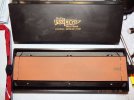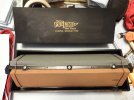- Joined
- Mar 28, 2020
- Messages
- 6,427
425M is essentially similar to 420HC in its makeup, with no significant hard carbide content at all. Not enough extra carbon in the steel to form hard carbides with other elements in it, like chromium. And just a tiny bit of vanadium (0.1%) for grain refinement. I have an older 4-dot Buck 112 in 425M, and it's essentially indistinguishable from Buck's 420HC in terms of how it sharpens up. I sharpen it on a Norton Fine India (aluminum oxide) most of the time, with occasional touchups on a medium Spyderco ceramic. Either stone type handles it easily and both leave a great finish on the edge, which is why I use those in particular. They're my favorites for that knife and for most of my others in 420HC and similar steels.
Sometimes, natural stones can be kind of marginal with stainless steels like these. But other synthetic stones of most any type should handle them without issue.
Maybe they made the steel in my knife too hard. How hard is your 425M? I don't know exactly how hard mine is because the 65Rc file is the hardest that I have in my set.




